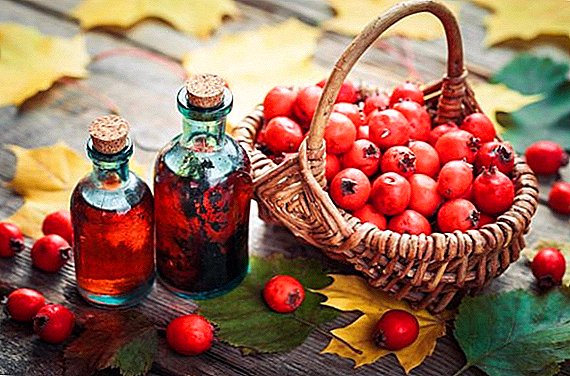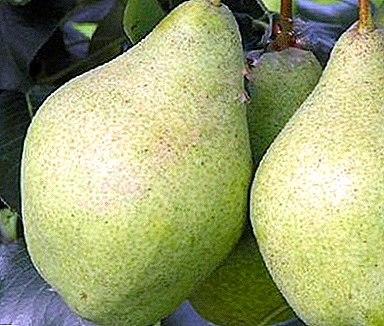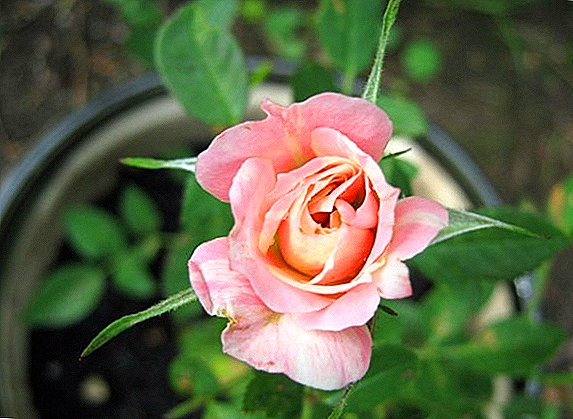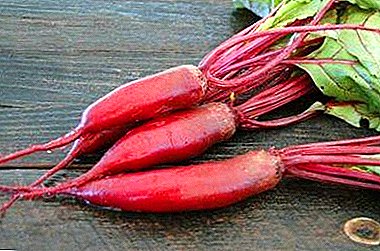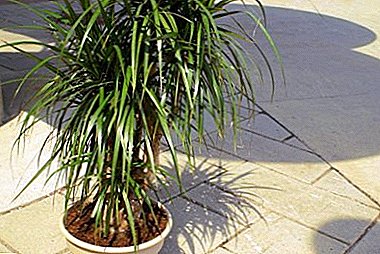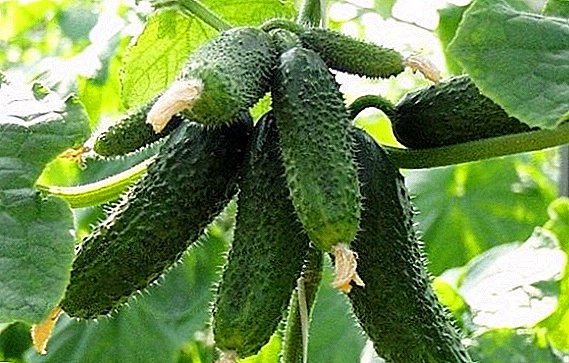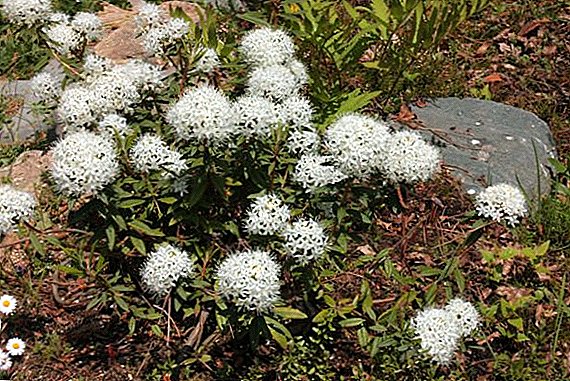 Ledum rosemary - evergreen shrub poisonous plant belonging to the heather family.
Ledum rosemary - evergreen shrub poisonous plant belonging to the heather family.
Ledum grows mainly in Europe, North America and Asia. The plant has a strong-branched bush structure and reaches a height of no more than 120 centimeters.
The aroma of wild rosemary bushes is very similar to the smell of camphor. Its inflorescences exude so strong intoxicating aroma that it is dangerous for health to be near the bushes during their flowering.
Did you know? In the people the wild rosemary swamp is also called the bakhun, bagunnik, bugun, puzzle, the marsh kanabra, the marsh hemlock, the stuffy bird, the big rape, the sleepy stupid, the forest rosemary and the bug insect.
Young non-lignified escapes of wild marsh Labrador tea covered with red fuzz. The leaves of the plant are leathery, linear-oblong, wintering. During the flowering period, the plant is covered with white flowers gathered at the ends of the branches in umbrellas. Bagulnik fruits are ferruginous-pubescent oblong-oval boxes. 
The chemical composition of wild rosemary
In the composition of the plant are present poisonous essential oils containing ice, η-cymol, palustrol, bicyclic alcohol, hydrocarbons and geranyl acetate. In addition to the roots, the essential oil is present in all parts of the wild rosemary.
In the leaves of the plant of the first year of life, the oil contains from 1.5 to 7.5%, and in the leaves of the bushes of the second year - from 0.25 to 1.4%, in the branches of the first year - from 0.17 to 1.5%, in the branches of the second year in an amount not exceeding 0.2%, in flowers - about 2.3%, and in fruits - about 0.17%.
The essential oil contained in the wild rosemary bogwort has a bitter-burning taste and a strong balsamic smell.
Important! In the period of flowering, the wild roseum grows deadly for human health, because at this time the plant releases into the air highly toxic substances that poison the body, causing a severe headache.
In addition, the plant contains glycosides (arbutin and ericoline), coumarins (scopoletin, esculin, umbelliferone, esculetin), andromedotoxin, flavonoids (hyperoside and quercetin), phytoncides, tannins and coloring matter, vitamin C, and an impressive list of macro- and trace elements. 
Healing properties of wild rosemary
Let's take a look at the benefits of a ledum and what diseases its reception can save a person. When using a plant, remember that everything is relative - benefit and harm, and therefore a poisonous ledum can both cure a person and kill.
Medicinal properties of wild rosemary of Bogulnik directly depend on the amount of essential oil contained therein. The higher the percentage of essential oil, the higher the healing potential of the plant.
Especially popular is the treatment of bronchitis with wild rosemary, because when used inside a plant, volatile substances present in its composition very quickly penetrate the lungs and stimulate the motor activity of the ciliated epithelium, which contributes to the rapid relief from the disease.
Did you know? In the process of excretion through the bronchi, biologically active volatile substances have a moderate local irritant effect on the respiratory mucosa, which increases the secretion and motor activity of the ciliary epithelium lining the respiratory tract.
Experts also note that wild rosemary has a slight antispasmodic effect on the smooth muscles of the bronchi. In addition, the plant has a pronounced anti-inflammatory effect, which also contributes to getting rid of bronchitis. 
Used for the treatment ointments, oils, powder and tincture of wild rosemary of the marsh. In traditional medicine, use the drug "Ledin", made on the basis of this plant and having a pronounced antitussive and bronchodilator effects.
Ledum essential oil has a stimulating effect on the central nervous system. Also, the plant has a diuretic effect. Essential oils that make up the plant are excreted through the kidneys with urine in unchanged form, which explains the positive effect on the urinary organs of essential oils and arbutin glycoside. Ledum marsh has a pronounced hypotensive effect.
Recipes of traditional medicine: treatment with wild roseum of various diseases
Despite the presence in the composition of wild rosemary toxic substances, its medicinal properties have found wide application in traditional medicine. Due to this, the plant is actively used for the treatment of various diseases.
As a medicinal raw material used flowers, leaves and wild rosemary. Tincture and decoction of wild rosemary have an expectorant and antitussive property that allows its use in the complex treatment of bronchitis, tracheitis, whooping cough, tuberculosis, asthma and laryngitis. 
In addition, the plant has proven itself in the treatment of such diseases of the musculoskeletal system, like rheumatism, arthritis and arthrosis deformans.
Also wild rosemary is used as part of complex therapy. in the treatment of diabetes, spastic enterocolitis, dysentery, scrofula and eczema, as well as an excellent diaphoretic, diuretic, disinfectant and hemostatic agent.
Important! When treating a plant, it is necessary to be extremely attentive, since non-compliance with the dosage can lead to undesirable consequences. What is dangerous Ledum swamp? The thing is that this is a poisonous plant, and therefore its incorrect use can cause irreparable harm to the body. Do not use wild rosemary without a doctor's prescription.
At home, the rosemary is used as an insecticide: they fumigate the rooms, decorate the plants with a decoction of places where bedbugs, mosquitoes and flies accumulate. Branches or powder of wild rosemary shift things to prevent the appearance of moths. And the essential oil of wild rosemary mixed with tar tan the skin. 
Did you know? Herb of the wild rose of the marsh instead of hops tried to use for making beer, but the experiment failed because, despite the fact that the drink turned out to be similar in taste to the original, it had higher heady properties, and, besides, caused severe headache, delirium and intestinal colic.
The plant is actively used for the treatment of pets. Horses are watered with a broth of wild rosemary for colic with opoy, for cows it is given for bloating, and for pigs for the prevention of infection with infectious diseases during an epidemic. Almost all domestic animals, with the exception of goats, Ledum leaves have a stupefying effect.
Despite its poisonous properties, the plant has an excellent antiallergic effect, which allows its use for the treatment of allergic forms of bronchial asthma, eczema and contact dermatitis.
In the treatment of the musculoskeletal system, a wild roseum ointment is used, which has anti-inflammatory and analgesic effects.
Tea from wild rosemary
 Tea from wild rosemary - This is an effective remedy for unproductive debilitating cough and shortness of breath, which can be used by both adults and children. It is necessary to take this drug for a long time - from 2 to 4 weeks.
Tea from wild rosemary - This is an effective remedy for unproductive debilitating cough and shortness of breath, which can be used by both adults and children. It is necessary to take this drug for a long time - from 2 to 4 weeks.
To achieve a therapeutic effect, adults should take a drink half a glass three times a day, children should be given one teaspoon of it no more than three times a day.
Making tea does not take much time. One tablespoon of dry grass of wild rosemary of marsh is poured with a glass of boiling water and allowed to brew for 15 minutes. To enhance the therapeutic effect, you can add one teaspoon of crushed nettle leaves to the drink.
Ledum oil
Oil of wild rosemary of marsh made on the basis of olive or sunflower oil: one tablespoon of chopped herb per 100 ml of base. Fill the grass with oil and place the vessel in a dark place for 21 days.
To improve the processes, it is necessary to shake the oil with grass at least once a day. After the time, the oil must be drained and poured into a dark container. The medicine can be used for instillation of the nose in acute and chronic rhinitis or sinusitis.
Cook the oil from wild rosemary can be one more way. To do this, you will need to take 1 tablespoon of wild rosemary flowers and pour 100 ml of sunflower or olive oil. The container should be set on fire, bring to a boil and simmer for one minute over low heat. Remove the container from the heat and condemn, letting it brew for another 24 hours, drain.
 The oil is rubbed into the lumbar region with radiculitis or into the joints during arthritis or deforming arthrosis, it can also be used for myositis and intercostal neuralgia.
The oil is rubbed into the lumbar region with radiculitis or into the joints during arthritis or deforming arthrosis, it can also be used for myositis and intercostal neuralgia.
If you make butter from wild rosemary for this recipe, then it can be used to treat acne, eczema and lichen. Stir 2 tablespoons of chopped herb into containers and cover with 5 tablespoons of sunflower oil. Capacity to close and put at 12 o'clock in a warm place.
Ledum ointment
Ledum based ointment, helps relieve pains in arthritis, arthritis and radiculitis, it will soothe pain in neuralgia and myositis.
To prepare the ointment of wild rosemary, It is necessary to take 200 g of internal pork fat and put it in a clay pot, add 25 g of crushed leaves there, cover the dishes with a lid and put them in the oven to stew for two hours at 100 ° C.
Ointment slightly cool, drain and pour into a container with a lid and a wide neck. It must be stored in the refrigerator.
Excellent remedy for scabies is considered ointment with wild rosemary and hellebore root. Take on a tablespoon of herbs of hellebore and wild rosemary and mix them with 500 g of pork fat. Put the container for 12 hours in the oven and simmer over low heat. Then strain the fat and pour into a glass container. Lubricate the affected areas 3 times a day.
Infusion of wild rosemary
 Infusion of wild rosemary possesses high wound healing properties. It is effective for torn and stabbed wounds, frostbite, burns, eczema and insect bites. You must take 2 tablespoons of the leaves of wild rosemary and pour a glass of boiling water, let it brew for 45 minutes, and then strain and bring to 500 ml of boiled water.
Infusion of wild rosemary possesses high wound healing properties. It is effective for torn and stabbed wounds, frostbite, burns, eczema and insect bites. You must take 2 tablespoons of the leaves of wild rosemary and pour a glass of boiling water, let it brew for 45 minutes, and then strain and bring to 500 ml of boiled water.
To prepare infusion of wild rosemary, It is necessary to pour 12 g of grass with a glass of boiling water and let it brew for 20 minutes. Infusion rub into the affected joints with arthritis, arthrosis, gout and radiculitis.
Another popular cooking recipe infusion for internal use used as a prophylactic agent during epidemics of ARVI, influenza and acute rhinitis. Pour 20 g of grass with one liter of boiling water and cook in the oven for 10 hours. Drink a decoction should be half a glass three times a day.
Alcohol tincture of wild rosemary
Alcohol tincture of wild rosemary It is considered an excellent remedy for gout, rheumatism, arthritis, eczema, as well as bronchitis, bronchial asthma. In addition, excellent results are given by the treatment with wild roseum inflammation of the small intestine and proctitis.
 To make an infusion, fill with five parts of vodka or alcohol one part of the crushed grass of wild rosemary of the marsh. Then you need to insist the drug in a warm dark place for 24 hours. Tincture is used externally to grind the affected joints or back. The rubbing perfectly anesthetizes and relieves inflammation.
To make an infusion, fill with five parts of vodka or alcohol one part of the crushed grass of wild rosemary of the marsh. Then you need to insist the drug in a warm dark place for 24 hours. Tincture is used externally to grind the affected joints or back. The rubbing perfectly anesthetizes and relieves inflammation.
Broth of wild rosemary
Broth of wild rosemary often used to treat organs of the respiratory, cardiovascular, and urogenital systems. The drug is recommended to take 0.5 cups 3 - a maximum of 4 times a day from 1 to 2 months.
Cooking broth of wild rosemary does not take much time. To do this, you will need to take 1 teaspoon of the crushed leaves of the plant and pour them with one glass of water, boil the drug for 15 minutes in a water bath, and then let it brew for another 45 minutes. After the infusion is infused, strain it.
Drug collection with wild rosemary
Medicinal fees are more popular than taking any single herb. The fact is that medicinal herbs collections have a wider range of effects, which allows to achieve better results in treatment.
For the treatment of dysentery it is necessary to prepare an infusion of 10 g of wild rosemary and 20 g of Althea root. Fill the collection of herbs with 1 liter of boiling water and the date shall be drawn for 60 minutes. Take the collection of dysentery should be every two hours, one tablespoon.

Dry cough save grass collection consisting of 5 tablespoons of wild rosemary, 10 spoons of Althea root, 10 tablespoons of coltsfoot. The whole herb is thoroughly mixed, take 2 tablespoons of the collection, pour them with boiling water and leave to infuse for 30 minutes. Take 0.5 cups of infusion 5 - 6 times a day 20 minutes before meals.
To relieve the condition of patients with bronchial asthma you need to prepare a collection consisting of 200 g of wild rosemary herb, 200 g of chamomile flowers, 60 g of birch buds and 40 g of ephedra herb. Brew 2 tablespoons of the collection of 500 ml of boiling water and let it brew for 5-6 hours, then strain. Take a drink 3 times a day for 0.5 glass 30 minutes before meals.
Collection and storage of medicinal raw materials
With the purpose of treatment they use young leafy shoots of wild marsh wild rosemary, which have not yet lignified. The collection of medicinal raw materials is carried out in late August or early September during the period of fruit ripening. When collecting shoots with a length of about 10 cm cut manually or cut shears.
Drying branches carried out in attics or in the shade on the street, in well-ventilated areas. Electric dryers can be used to dry the plant, and the device should not be switched on by more than 40 ° C.
When drying a wild rosemary it is necessary to be especially careful, as the plant is poisonous, and if you stay near the grass all the time, this can cause you a severe headache. 
When collecting and drying the grass, all manipulations must be performed in a respirator or cotton-gauze dressing. Raw materials are stored in paper bags or glass jars.
Contraindications and side effects
Treatment with wild rosemary should be carried out under the supervision of a physician, since the benefits of taking it must necessarily be correlated with contraindications, which is explained by the presence of toxic substances in its composition.
Important! Treatment with wild rosemary must be carried out only with the permission of a physician, because in some conditions the plant can cause severe discomfort. The use of wild rosemary in dosages exceeding the norm is prohibited, since it can cause headache and increased nervous irritability.
In addition, despite the high therapeutic potential, the use of wild rosemary is forbidden in case of mental disorders, emotional lability, hypotension, arrhythmia, and propensity to stop breathing.
Of course, wild rosemary is a poisonous plant, but before mindlessly destroying it, consider what diseases it can help you to get rid of.


